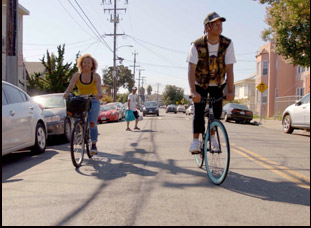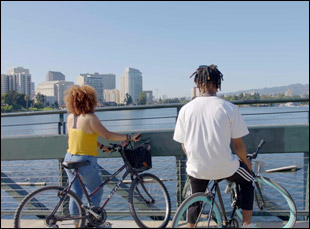Although Nico Opper and Shannon St. Aubin knew that they would be preserving a little bit of Oakland history with “When I Write It,” they had no idea how quickly that realization would set in when Solespace, the setting for the film’s climactic concert, ended up closing shortly after they wrapped filming.
“Unfortunately, the bitter reality of making a film that ends up being largely a story about gentrification is that lovely store that sold sneakers and served as a performance space ended up closing, so we lost it,” recalls Opper. “We found out about that a couple weeks after we finished or we would’ve given a little RIP to it. It was heartbreaking. It had been such a central place for young people.”
While the economic and cultural shifts that have been wrought by the tech industry in full flourish have left increasingly less room for the kind of communal places long cherished by Bay Area residents, particularly its African-American community who have made Oakland a wellspring of organizing and activism, Opper and St. Aubin open up that space on screen with their beautiful short film, which follows teenagers Leila Mottley and Ajai Kasim on a bike ride through the city, looking to be inspired to write a piece of music for a performance by Kasim’s band Jazz on the Sidewalk. They may cruise around with notebooks in hand, thinking of lyrics in between stops at taco trucks that still hold some of the old flavor of town and the stores that sell $77 bandannas that do not, but it is you that becomes inspired watching these hyper-articulate high schoolers weaned on Toni Morrison and Shawn Ginwright’s “Black Youth Rising” expressing themselves and navigating their way forward in a world that feels as if it’s being pulled away from them.
A bit like “Before Sunrise” on a sunny day in Oakland, it is the kind of splendid exchange between two people that makes everything else fall away in the time you spend watching it and fortunately, following its planned premiere at the Tribeca Film Festival last month, “When I Write It” is being made available online both as part of Hot Docs, where residents of Toronto can watch it now, and later this week at the We Are One Film Festival, where it will be streaming on YouTube for all. Opper and St. Aubin were kind enough to talk about their love letter to the city and finding such thoughtful and introspective subjects to follow.

Shannon St. Aubin: Nico had this idea germinating, inspired by some of these kids in Oakland and collected this group of people together, and then I got a call, like “Hey, do you want to do this together?”
Nico Opper: I begged her. [laughs] We initially just set out to make a film about young musicians shaped by their city. We didn’t know who or how that would take place and then Ajai Kasim came into the picture. We were just blown away by his talent and his passion and then in this really organic way, a friend pointed me towards Leila, who had such a gift for poetry. I was struck by her political awareness and all the work she did around social justice. They both happened to attend Oakland School of the Arts and they knew each other casually, but not well, so they were excited when they met up, and immediately, it was like, “Hey, let’s collaborate on a piece of music together.” That’s when Shannon and I knew we had a film.
Shannon St. Aubin: It just fell together in that way the best things do. It just felt right, and just felt like this collective of people – us and the kids – coming together.
Was the idea of a bike ride through the city their idea or yours?
Nico Opper: The ideas were driven by Leila and Ajai where we basically sat around a kitchen table several times and brainstormed a storyline collectively, which is why they’re credited as co-writers. Nothing was scripted, but there was a bike trip in Oakland and a collaboration that results in this private concert and those were conceived for the purpose of this film, and after we determined the kind of container we could be working within, the actual interactions between them and all of the music that they played could just flow. None of that was rehearsed or predetermined in any way. I’ve always considered this film to be a hybrid project in terms of our creative process because we all got to sit around and imagine what certain scenes would look like and imagine even a narrative arc that might emerge over the course of an eight day shoot. That was an exciting experiment. I’d never approached a documentary this way before as a filmmaker. Usually I’m in production for years.
Shannon St. Aubin: They’re both very bicycle-driven. Leila drives, but Ajai didn’t, so that came from how they get around the city, and when we were talking about how they lived their lives, that became part of just the fabric of this is how they spend their time and this is part of who they are. We also talked about that as part of an age-old transportation justice piece around black kids and transportation and what that means in order to move yourself throughout a city.
Does this take you anywhere that was unexpected?
Shannon St. Aubin: Temescal Alley or what we call “Gentrification Alley” [a strip mall for boutique stores] felt like [a surprise]. We didn’t really plan that so much as we were shocked by it. That felt unexpected.
Nico Opper: The alley is a good one and the other for me is really that mural, because [it’s] on the side of the wall that houses the Critical Resistance, which is a grassroots organization aiming to abolish the prison industrial complex. What used to be a baby clothing store in Oakland they turned into their headquarters for activism and they painted these gorgeous murals on the exterior. We found out about that midway through our shoot, so we quickly figured out how we could integrate it into our story. It ended up being the catalyst for a conversation that Leila and Ajai had on the sidewalk instead of a whole discussion of prison abolition, but it still added some flavor to the film that I’m not sure would’ve otherwise been there.
Shannon St. Aubin: It’s a short, so we had a lot of trimming to do and exploration because the lives these two kids lead are so rich. One of the things that Leila touches on in the film is her abolition work around youth justice, but she’s actually pretty involved in that movement and working with kids, so we had this whole idea centered around a youth justice facility, but during the process of filming, certain things just didn’t end up feeling how we thought they would feel.
Nico Opper: Yeah, it’s true. We had a much longer cut that was much more expositional and as we went through the edit process we realized we didn’t need a lot of it, so that all kind of fell away.

Nico Opper: Oh we meandered. [laughs] We have to give a lot of credit to our editor Laura Green because we would let conversations go on for hours. I love to just slip into it and ignore the clock if I can.
Shannon St. Aubin: Yeah, they’re teenagers, so you just never know what they’re going to say and we had a lot of nuggets of teenage wisdom that we had to get rid of that we were really sad to. But I love it so much. We got to the 17-minute mark and I was like, “We’re good.”
Nico Opper: Yeah, we had a 42-minute assembly, but allowing for those conversations to play out had to be a part of our process because we really were witnessing a friendship blossoming in front of the camera.
Shannon St. Aubin: I’m more of a narrative filmmaker and as a documentarian, Nico likes to collect what’s said. Because they traveled in the same circles — both have been in Youth Speaks and they went to the same school — but they really didn’t socially interact until we put them together, there were times when they’d go off and we would just have them mic’d and listen to them building a friendship and Nico would have to hold me back, [saying] “Just let them bond.” It was really nice to witness.
One of my favorite scenes is when you shoot them at a remove when they’re at the park and you see Leila in the foreground on the grass and Ajai down by the docks. Was that an image that caught your eye on the day?
Nico Opper: That was [our cinematographer] Hanna Miller who [shot] for us and we spent a full day at Lake Merritt…
Shannon St. Aubin: A full, hot day at the lake. [laughs]
Nico Opper: A full hot day. That was one of the scenes we knew was going to be a really central scene to the film, so we just allowed ourselves to really be present in the moment and let them have some writing time solo. Then afterward we’d bring them together and see how they made sense of what they wrote and how they shaped it and changed it for one another. That [shot] you mentioned probably came out of an hour of Hanna quietly filming two young people being introspective and creating their art.
It’s also really lovely how you set this up by peeking in on their home lives with their families for just a moment before they take off on their bikes. How did you decide to go shoot that?
Nico Opper: We’re glad you like them.
Shannon St. Aubin: We had so many people tell us you don’t need them and we felt that we did. They both come from really interesting families and we don’t get to see inside of black life very often, so we wanted to get this glimpse inside. You have a multiethnic household with Leila’s family and then [you see] Ajai’s family where you just get this commonality of they’re still just teenagers and everybody eats dinner. They still have people that cook for them most of the time, and even though they’re trying to do this flight off into adulthood, they still have this role as sons and daughters. That is pretty significant, even if it was just for a second [in the film].
Nico Opper: Yeah, clearly, the film is not about their families, but even though there’s not a lot of dialogue in those scenes, just to see them as members of those families and to understand them as sons and daughters and their relationships to these other people and how their body language changes inside their own homes – that was important for us, particularly when they’re in such a transitional moment. They’re going off to live their own lives, so that context was needed even if it only plays on a subconscious level.
As if this wasn’t joyous enough, it ends with someone dancing alongside the end credits. Who was that?
Shannon St. Aubin: That was Tosh, who was actually at our first little meeting at the coffee shop. He’s close friends with Ajai and he’s in Ajai’s band and sings backup, so you’ll notice him in the scenes he also is singing, but he’s a little bit different than the two of them are — he has this buoyancy to him [whereas] they are a lot more weighted, and he lives in San Francisco [as opposed to Oakland], so that’s why there’s the ferry, so we just really liked ending on this note of this sense of freedom that he had.
Even though this wasn’t able to have its physical premiere just yet, have you been able to share this with the families?
Nico Opper: Yeah, we did. We got to watch it with Leila and Ajai and then Ajai’s mom and his little brother came over, which was a little bit spur of the moment. Of course, it was just supposed to be a quick preview before we all headed to New York together for the Tribeca premiere, so they haven’t seen it on the big screen with great sound yet, but we’re excited to do that. We’re not giving up on that dream. That’s going to happen.
“When I Write It” will be available to stream through DOC NYC as part of Shorts Program: Art Time from November 11th through 19th. It’s also currently available to watch through PBS.




